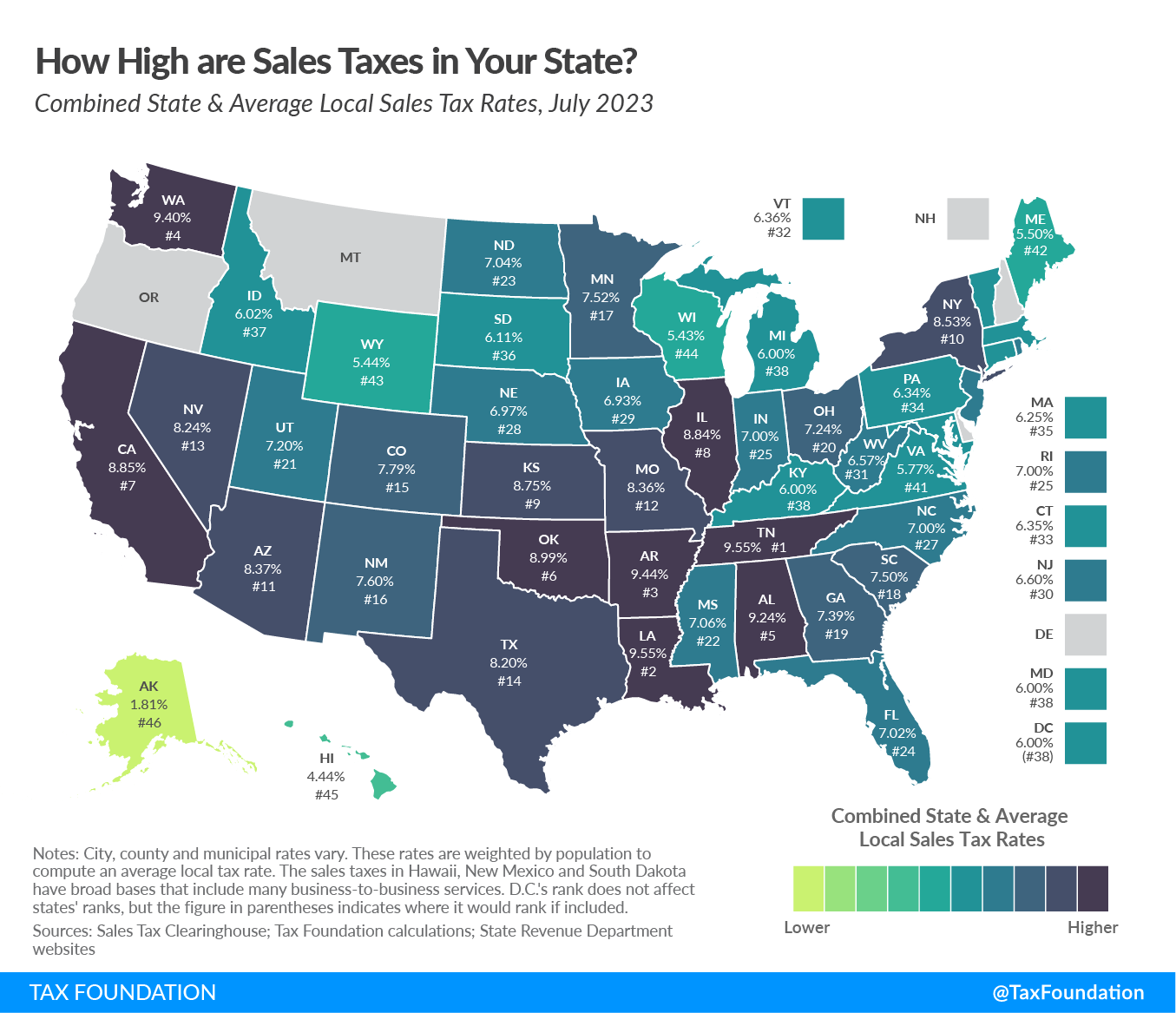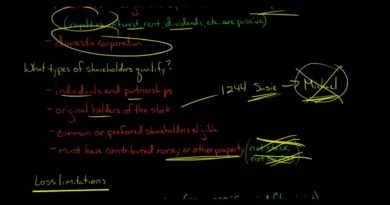State and Local Sales Tax Rates, Midyear 2023
Key Findings
- Forty-five states and the District of Columbia collect statewide sales taxes.
- Local sales taxes are collected in 38 states. In some cases, they can rival or even exceed state rates.
- The five states with the highest average combined state and local sales tax rates are Tennessee (9.548 percent), Louisiana (9.547 percent), Arkansas (9.44 percent), Washington (9.40 percent), and Alabama (9.24 percent).
- South Dakota cut its state sales tax rate from 4.5 to 4.2 percent effective July 2023, the most recent statewide rate reduction since New Mexico trimmed its sales tax rate from 5.125 percent to 5 percent in July 2022.
- Sales tax rates differ by state, but sales tax bases also impact how much revenue is collected from a tax and how the tax affects the economy.
- Sales tax rate differentials can induce consumers to shop across borders or buy products online.
Introduction
Retail sales taxes are an essential part of most states’ revenue toolkits, responsible for 32 percent of state tax collections and 13 percent of local tax collections (24 percent of combined collections). They also benefit from being more pro-growth than the other major state tax, the individual income tax, because they introduce fewer economic distortions.
Forty-five states impose state-level sales taxes, while consumers also face local sales taxes in 38 states, including Alaska, which does not impose a statewide tax. These local rates can be substantial, and some states with moderate statewide sales tax rates actually impose quite high combined state and local rates compared to other states. This report provides a population-weighted average of local sales taxes as of July 1, 2023, to give a sense of the average local rate for each state. Table 1 provides a full state-by-state listing of state and local sales tax rates.
Combined Rates
Five states forego statewide sales taxes: Alaska, Delaware, Montana, New Hampshire, and Oregon. Of these, only Alaska allows localities to impose local sales taxes.[2]
The five states with the highest average combined state and local sales tax rates are Tennessee (9.548 percent), Louisiana (9.547 percent), Arkansas (9.44 percent), Washington (9.40 percent), and Alabama (9.24 percent). The five states with the lowest average combined rates are Alaska (1.81 percent), Hawaii (4.44 percent), Wisconsin (5.43 percent), Wyoming (5.44 percent), and Maine (5.50 percent).
State Rates
California has the highest state-level sales tax rate, at 7.25 percent.[3] Four states tie for the second-highest statewide rate, at 7 percent: Indiana, Mississippi, Rhode Island, and Tennessee. The lowest non-zero state-level sales tax is in Colorado, which has a rate of 2.9 percent. Five states follow with 4 percent rates: Alabama, Georgia, Hawaii, New York, and Wyoming.[4]
Only South Dakota cut its state sales tax rate this year. Unusually, the reduction—from 4.5 to 4.2 percent—is temporary, expiring in four years. The Mount Rushmore State follows on the heels of New Mexico, which lowered the rate of its state-level sales tax—a hybrid tax the state refers to as its gross receipts tax—from 5.125 percent to 5 percent in July 2022. Notably, if the revenue from the gross receipts tax in any single fiscal year from 2026 to 2029 is less than 95 percent of the previous year’s revenue, then the state’s rate will return to 5.125 percent on the following July 1.
Before that, the most recent statewide rate reduction was Louisiana’s cut, from 5.0 to 4.45 percent, in July 2018. State lawmakers have instead prioritized income tax cuts, which yield more economic benefit, reducing individual or corporate income tax rates (or both) in two dozen states in the past two years alone.
Local Rates
The five states with the highest average local sales tax rates are Alabama (5.24 percent), Louisiana (5.10 percent), Colorado (4.89 percent), New York (4.53 percent), and Oklahoma (4.49 percent).
Only South Dakota and Vermont saw a ranking change of more than one place since January. While South Dakota improved four places overall due to its lower state rate, Vermont slid three places due to local rate increases. Florida, Illinois, and Wisconsin also improved by one place, while California, Tennessee, North Dakota, and Wyoming slid one spot either due to local sales tax changes in those states or their nearest peers.
In Vermont, voter-approved rate increases in Shelburne, Stowe, and Rutland drove the combined rate higher. Wyoming’s Sweetwater County adopted a new 1 percentage point levy. Ballot measures in California drove higher rates in many jurisdictions, from Malibu (0.5 percent increase) to Modesto (1 percent) and parts of Kern (1 percent), among others.
Some cities in New Jersey are in “Urban Enterprise Zones,” where qualifying sellers may collect and remit at half the 6.625 percent statewide sales tax rate (3.3125 percent), a policy designed to help local retailers compete with neighboring Delaware, which forgoes a sales tax. We represent this anomaly as a negative 0.03 percent statewide average local rate (adjusting for population as described in the methodology section below), and the combined rate reflects this subtraction. Despite the slightly favorable impact on the overall rate, this lower rate represents an implicit acknowledgment by New Jersey officials that their 6.625 percent statewide rate is uncompetitive with neighboring Delaware’s lack of a sales tax.
The Role of Competition in Setting Sales Tax Rates
Avoidance of sales tax is most likely to occur in areas where there is a significant difference between jurisdictions’ rates. Research indicates that consumers can and do leave high-tax areas to make major purchases in low-tax areas, such as from cities to suburbs. For example, evidence suggests that Chicago-area consumers make major purchases in surrounding suburbs or online to avoid Chicago’s 10.25 percent sales tax rate.
At the statewide level, businesses sometimes locate just outside the borders of high sales-tax areas to avoid being subjected to their rates. A stark example of this occurs in New England, where even though I-91 runs up the Vermont side of the Connecticut River, many more retail establishments choose to locate on the New Hampshire side to avoid sales taxes. One study shows that per capita sales in border counties in sales tax-free New Hampshire have tripled since the late 1950s, while per capita sales in border counties in Vermont have remained stagnant. At one time, Delaware actually used its highway welcome sign to remind motorists that Delaware is the “Home of Tax-Free Shopping.”
State and local governments should be cautious about raising rates too high relative to their neighbors because doing so will yield less revenue than expected or, in extreme cases, revenue losses despite the higher tax rate.
Sales Tax Bases: The Other Half of the Equation
This report ranks states based on tax rates and does not account for differences in tax bases (e.g., the structure of sales taxes, defining what is taxable and nontaxable). States can vary greatly in this regard. For instance, most states exempt groceries from the sales tax, others tax groceries at a limited rate, and still others tax groceries at the same rate as all other products. Some states exempt clothing or tax it at a reduced rate.
Tax experts generally recommend that sales taxes apply to all final retail sales of goods and services but not intermediate business-to-business transactions in the production chain. These recommendations would result in a tax system that is not only broad-based but also “right-sized,” applying once and only once to each product the market produces. Despite agreement in theory, the application of most state sales taxes is far from this ideal.
Hawaii has the broadest sales tax in the United States, but it taxes many products multiple times and, by one estimate, ultimately taxes 119 percent of the state’s personal income. This base is far wider than the national median, where the sales tax applies to 36 percent of personal income.
Methodology
Sales Tax Clearinghouse publishes quarterly sales tax data at the state, county, and city levels by ZIP code. We weight these numbers according to the most recent Census 2021 population figures to give a sense of the prevalence of sales tax rates in a particular state. This is a change from previous editions, where we used figures available every decade. While changes due to the new weighting were mostly trivial, we show changes in rank based on January 1 figures recalculated under the new population weighting. Due to the updated population weighting, this report is not strictly comparable to previously published editions, though differences amount to minor rounding errors.
It should also be noted that while the Census Bureau reports population data using a five-digit identifier that looks much like a ZIP code, this is actually a ZIP Code Tabulation Area (ZCTA), which attempts to create a geographical area associated with a given ZIP code. This is done because a surprisingly large number of ZIP codes do not actually have any residents. For example, the National Press Building in Washington, D.C., has its own ZIP code solely for postal reasons.
For our purposes, ZIP codes that do not have a corresponding ZCTA population figure are omitted from calculations. These omissions result in some amount of inexactitude but overall do not have a significant effect on resultant averages because proximate ZIP code areas that do have ZCTA population numbers capture the tax rate of those jurisdictions.
Conclusion
Sales taxes are just one part of an overall tax structure and should be considered in context. For example, Tennessee has high sales taxes but no income tax, whereas Oregon has no sales tax but high income taxes. While many factors influence business location and investment decisions, sales taxes are something within policymakers’ control that can have immediate impacts.
Stay informed on the tax policies impacting you.
Subscribe to get insights from our trusted experts delivered straight to your inbox.
Subscribe
[1] The author would like to thank Benjamin Jaros and Zachary Esses Johnson for their research contributions.
[2] Special taxes in Montana’s resort areas are not included in our analysis.
[3] This number includes mandatory add-on taxes that are collected by the state but distributed to local governments. Because of this, some sources will describe California’s sales tax as 6.0 percent. A similar situation exists in Utah and Virginia.
[4] The sales taxes in Hawaii, New Mexico, and South Dakota have bases that include many business services and so are not strictly comparable to other sales taxes.






